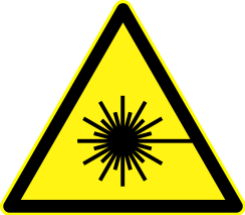Safety Risks: Laser Safety
Introduction
Lasers are widely used at CERN for research, alignment, measurement, and various technical applications. While lasers provide significant advantages in precision and efficiency, they also present potential hazards to personnel, including eye and skin injuries, fire risks, and secondary hazards related to reflections and optical components.
Laser Safety Rule at CERN
The safe use of Lasers is governed by IS22 – Safety Instruction for Laser Hazards at CERN
🚧 NEW RULES ARE UNDER REVISION. THESE WILL BE PUBLISHED SOON 🚧
Contents
Important note regarding laser pointers :Laser pointers with a classification above Class 1 are strictly prohibited in Switzerland. There have been at least two instances where CERN staff or Users were arrested and fined over CHF 1,000 for possession of a laser pointer exceeding Class 1. Permitted Class 1 laser pointers can now be purchased from the CERN stores with SCEM code 54.21.50.001.7 The following poster can be displayed in meeting rooms and event spaces to maintain awareness: EDMS 3304489. |
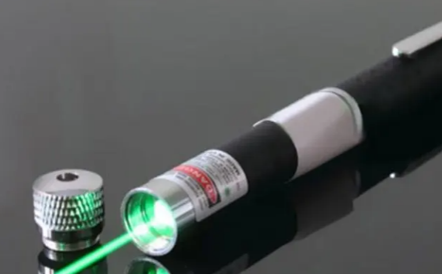 |
Laser Classifications
Lasers are categorized according to EN 60825-1, which defines seven classes based on their hazard level:
-
Class 1 – No hazard under normal use
-
Class 1M – No hazard unless viewed with optical instruments
-
Class 2 – Low-power visible lasers; eye protection provided by normal aversion response
-
Class 2M – Similar to Class 2 but hazardous if viewed with optical instruments
-
Class 3R – Low risk but may be hazardous if viewed directly
-
Class 3B – Direct beam exposure hazardous; reflections may also be harmful
-
Class 4 – High-power lasers that pose serious risks to eyes and skin and can ignite materials
At CERN, the use of Class 3 and Class 4 lasers requires special authorization, controlled access, and safety measures.
Important note: for optical fibres with a hazard level ≥ Class 3 or Class 4 (e.g., Power Over Fibre) not implemented in a DLA, the following requirements must be met:
-
All cabling and conduits must be properly labelled.
-
Class 3 Beams: Optical fibres must be enclosed within a rigid conduit to mitigate the risk of radiation exposure above the Maximum Permissible Exposure (MPE) level.
-
Class 4 Beams: Optical fibres must be protected within an armoured or fireproof cladding, or enclosed in a metal conduit.
Designated Laser Areas
DLAs are areas where Class 3 and 4 lasers are operated. The following requirements apply:
-
Registration in NIRREG
-
Laser Safety File with risk assessments and control measures
-
Restricted access, requiring authorized personnel only
-
Initial inspection with LSO prior to starting the laser and then Safety inspections conducted annually
Embedded lasers (or laser box) in equipment must have:
-
Secure enclosures preventing accidental exposure
-
Fail-safe interlock systems
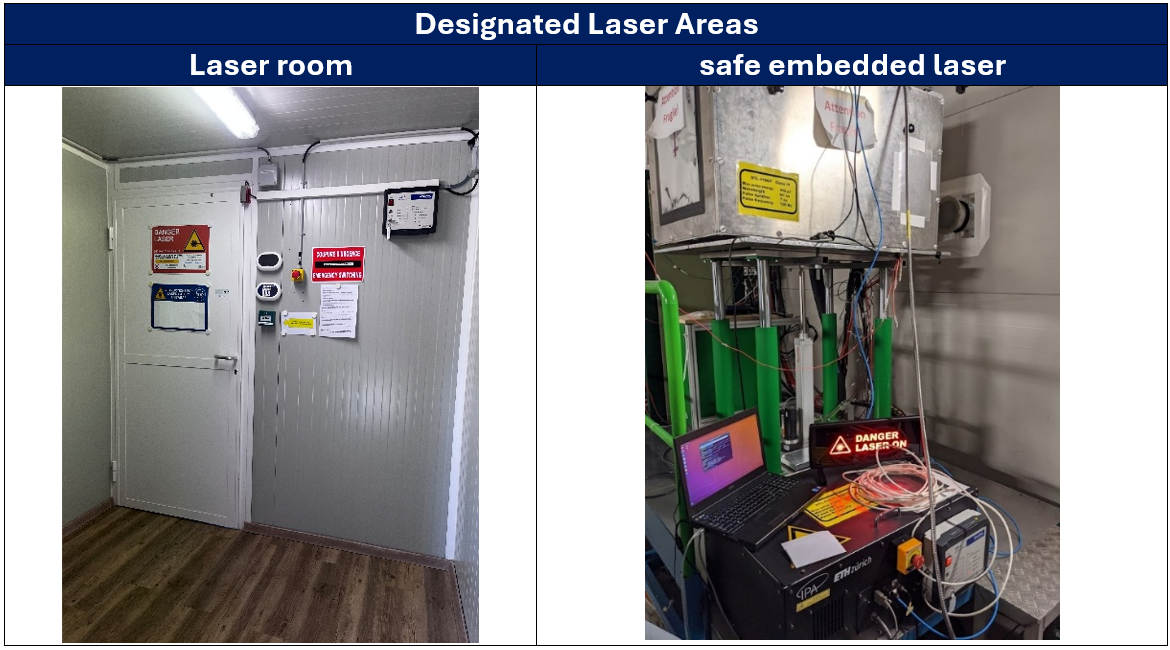
Roles and Responsibilities
Laser Users
-
Training Requirements: Users must complete both the Laser Safety Awareness eLearning and User training, and receive a specific briefing from the LSSO for the DLA they are allocated to.
-
DLA Access: Laser Users are granted access to the DLA they assigned to by the LSSO only after completing the required elearning trainings and specific DLA safety briefing.
-
Safety & Compliance: Laser Users must work strictly within the limits and procedures defined by the LSSO, as specified in the Operating Procedures and Briefing Record form.
Laser Safety Support Officer (LSSO)
-
Appointment: The LSSO is responsible for the laser safety in their assigned Designated Laser Areas (DLAs). They are appointed by the relevant CERN Leader in consultation with the LSO and either the DSO or LEXGLIMOS.
-
Responsibilities: The LSSO ensures compliance with CERN Safety Rules by registering the lasers and DLA in NIRREG, maintaining the Laser Safety File, implementing control measures, managing access to the DLA, overseeing training, and organizing inspections in collaboration with the LSO.
-
Training requirements: LSSO must follow the 2 Day LSSO safety training to understand CERN specific rules, procedures and mitigation measures.
For more details see GSI-SO-14 Laser Safety Support Officer
Laser Safety Officer (LSO)
-
Responsibilities: The LSO is a Specialized Safety Officer (SSO) who assists Departmental Safety Officers (DSOs) or LEXGLIMOS in overseeing laser safety within departments and large experiments, supports the nomination of LSSOs, and advise LSSO in the implementation of safety measures within their Laser Designated Laser Areas (DLAs) and installations, including reviewing Laser Safety Files.
-
Inspection: The LSO conducts initial safety inspections of new DLAs or laser installations and documents them in the Non-Ionising Radiation Register (NIRREG). LSO can also conduct random safety visit if necessary and investigate unsafe situations.
-
Collaboration: The LSO liaises with other LSOs and HSE representatives to enhance laser safety and contribute to safety improvements during Laser Safety Officer Committee (LSOC).
For more details see GSI-SO-11 Specialised Safety Officer
Laser Safety Expert (LSE)
-
Role & Responsibilities: Overseeing and supporting the implementation of laser safety across the entire CERN Organization.
-
Development of Policy, Procedures, & Trainings: The LSE supports the development and implementation of Laser Safety Rules, creates safety procedures and tools (including a Class 3 and 4 laser inventory), and designs Laser Safety Training for officers and users.
-
Investigate laser-related incidents.
Note: For more details see Nomination LSE – role and description EDMS 3245648
Useful Contacts
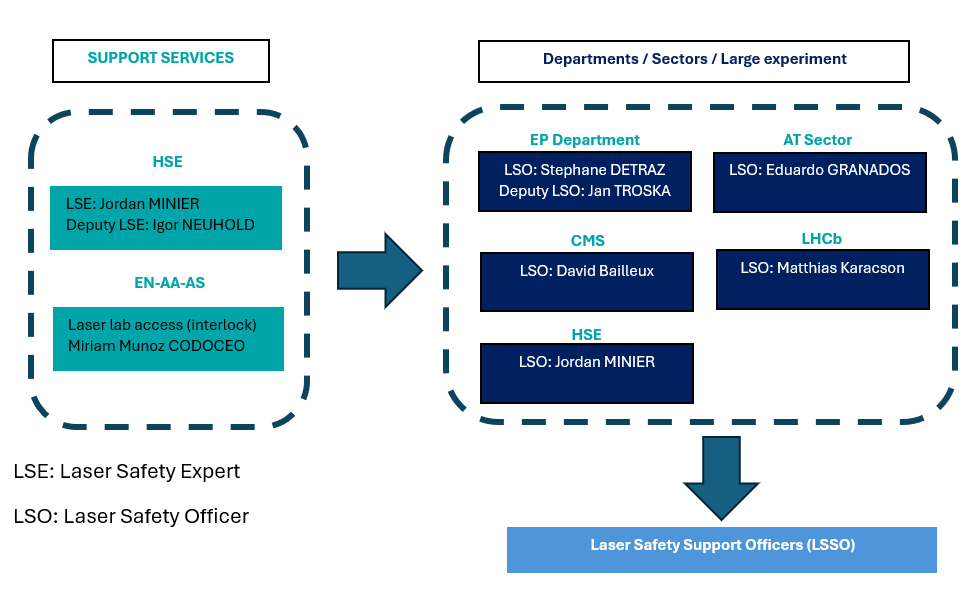
Laser Hazards
-
Eye injuries
-
Eye injuries: Lasers can cause retinal burns, permanent vision loss, or even total blindness. The severity of damage depends on the wavelength, exposure time, and irradiance.
-
UV-C and UV-B: Corneal damage (e.g., photokeratitis from welding arcs).
-
UV-A: Cataract formation in the lens.
-
Visible & IR-A (400–1400 nm): Most dangerous, can cause retinal burns and permanent blindness.
-
IR-B: Corneal burns - Cataract
-
IR-C: Corneal burns
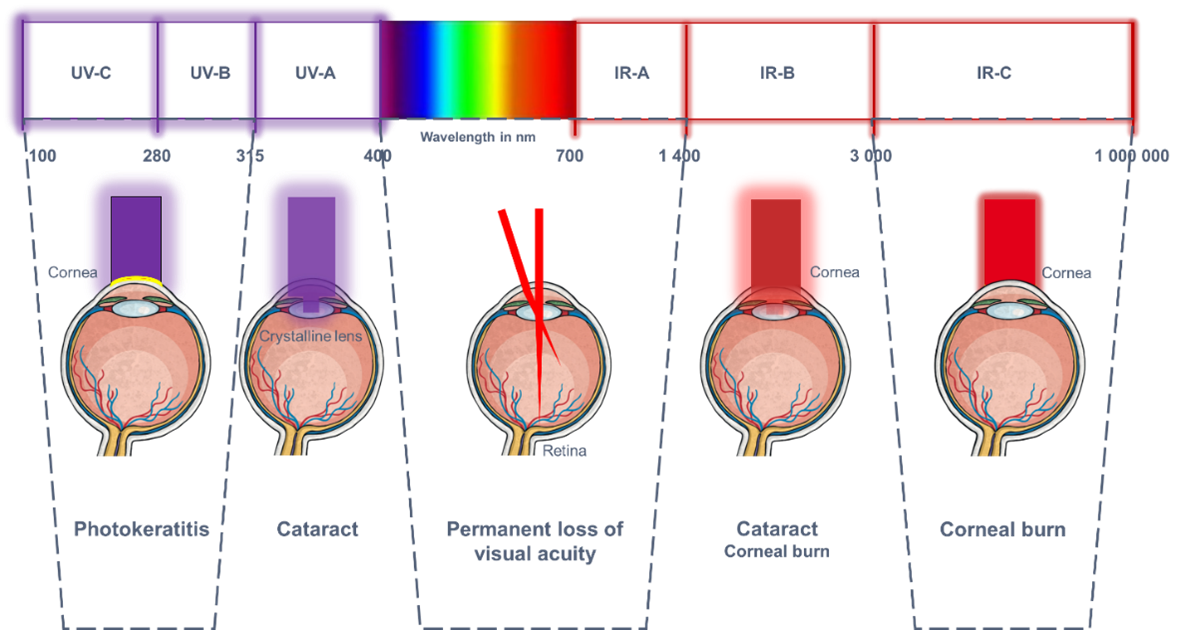
-
-
Skin injuries: High-power lasers can cause thermal burns, photochemical damage, and tissue carbonization.
-
UV exposure: Accelerates skin aging and can cause long-term cellular damage.
-
Infrared lasers: Can cause severe burns that penetrate deep into the dermis.
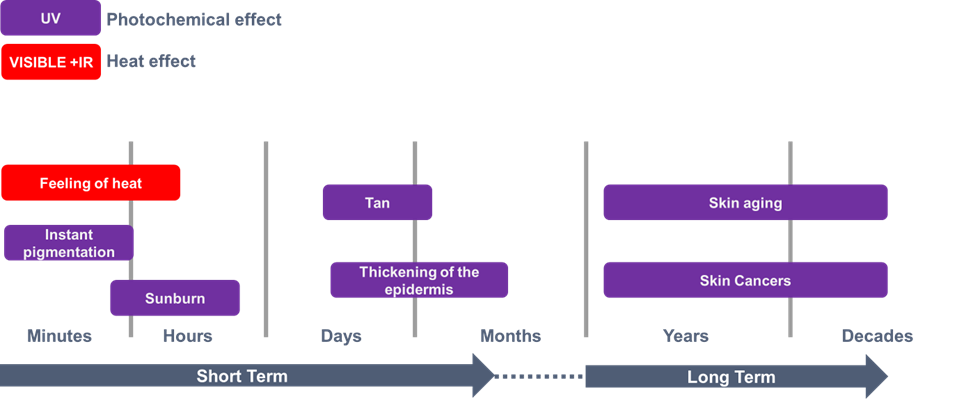
-
-
-
Other non-beam Hazards
-
High-power lasers (Class 4) can ignite flammable materials.
-
Electrical risks arise from high-voltage laser power supplies.
-
Secondary radiation (e.g. fluorescence) which can cause damage to tissues and materials.
-
Toxic fumes from laser-material interactions.
-
Mechanical hazards from moving optical components.
-
Reflections from mirrors or polished surfaces.
-
Safety Inspections and Incident Reporting
1. Inspections
- Initial Inspection: before the initial operation of a new laser, a laser safety inspection should be performed by the LSSO, LSO and (optionally) the HSE LSE.
- Annual Self-Inspection: every year, the LSSO should review the Laser Safety File and carry out a self-inspection.
- After Significant Change: In case of modification in the DLA, the LSSO should update the Laser Safety File and carry out an inspection with the LSO and (optionally) the HSE LSE.
- After any incident involving the laser: The Laser Safety File should be updated to include additional safety measure to eliminate or reduce the risk that caused the accident. An inspection should be carried out with the LSO and HSE LSE.
- Random safety-visit: LSO and/or DSO, HSE can carry out random safety visit.
Important Note: The self-inspection is carried out by the LSSO every year. The LSO does not need to attend this self-inspection. The inspection is done using NIRREG work order (see NIRREG manual EDMS 2705375 for more information). Usually, an alert is sent by NIRREG as reminder.
2.Incident Reporting
- ⚠ Emergencies: Contact CERN Fire Brigade on +41 22 76 74444 ⚠
- Medical Issues: CERN Medical Service (Tel. 73802, Bldg. 57).
- Near Misses & Accidents: must be reported via Incident Declaration Form.
Additional Resources
For further information, contact your LSO or the HSE Laser Safety expert: laser-safety-experts@cern.ch
- Laser Safety File: document prepared by the LSSO that contains all relevant information and procedures related to the safe use of lasers in a particular environment or setting. A template is available here EDMS 2675947.
- CERN Laser Safety Training available via the learning hub.
- NIRREG: The DLA & Laser register, maintained on the Infor-EAM platform cern.ch/nirreg. A user guide is available here EDMS 2705375.
- Operating procedures and safety briefing record: This form comprehensively outlines all laser procedures and the individuals authorised to perform them. Every laser user must sign this form to confirm comprehension of all communicated information provided by the LSSO. A template is available here EDMS 2966372.
- Standard IEC 60825-1: Safety of Laser Products available here EDMS 2721735
- Laser safety warning signs: Available at CERN store (SCEM 50.55.82.E)
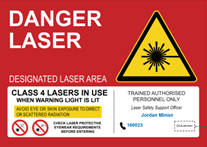
Laser safety posters
Prohibition of laser pointers above class 1
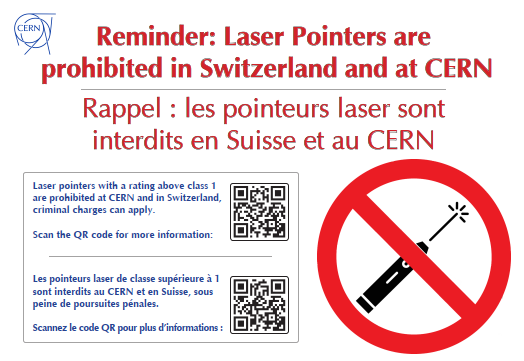 Available here: EDMS 3304489.
Available here: EDMS 3304489.
Laser engraving machines
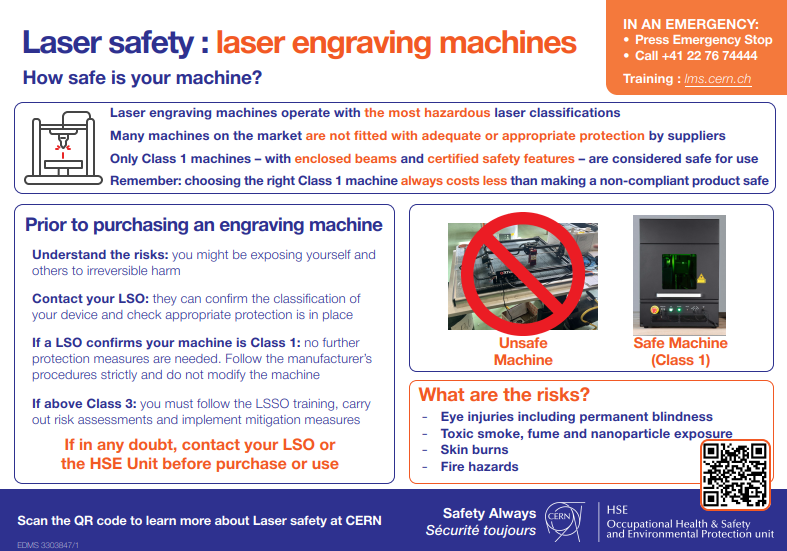 Available here: EDMS 3303847.
Available here: EDMS 3303847.

